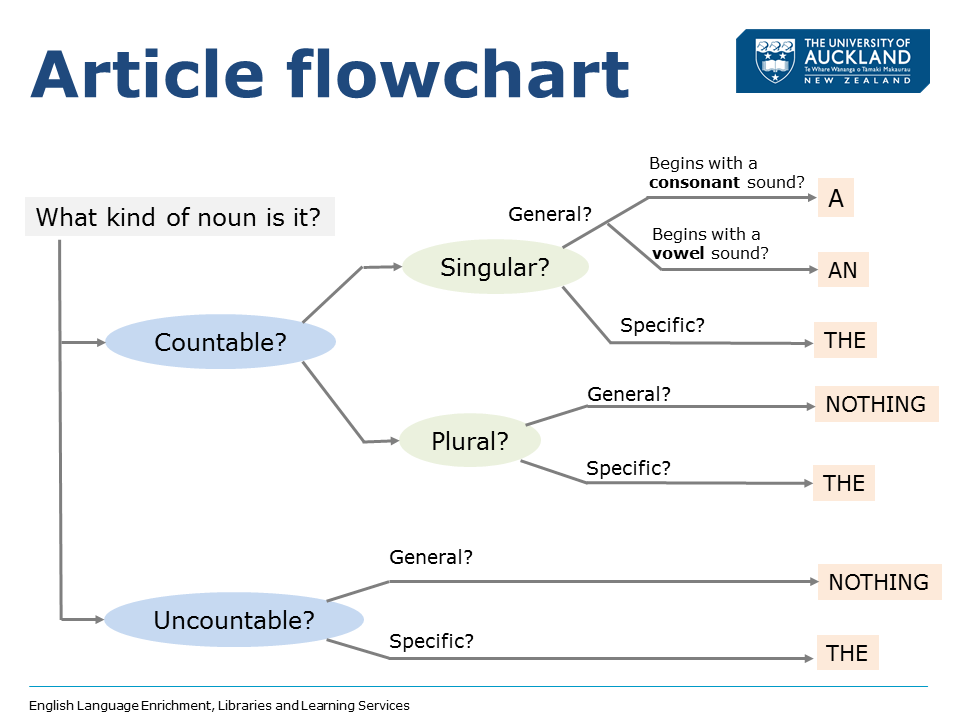Articles
Why study articles?
English nouns (words for a person, place, thing, or quality) have to be identified in some way. You use articles (a, an, the) in front of nouns to signal to the reader what you are referring to: a single entity, multiple or generic entities, or a specific entity. When used correctly, articles can add clarity to your writing.
Main problems of use
The main problems with English articles relate to the following:
when to use them and when to leave them out
which articles to use - indefinite articles (a or an) or the definite article (the) or no article (Ø)
the use of articles with countable nouns (nouns with plural forms; e.g. girl-girls, city-cities), uncountable nouns (nouns that do not have a plural form, e.g. news, work, information, equipment, knowledge, and proper nouns (name of a person, place, or thing, e.g. Auckland University)
If you do not yet make these decisions automatically, you need to think about:
1. What type of noun you are using
2. What context you are using the noun in:
a. specific (pointing to something exactly)
b. general (referring to anything everywhere)
c. number (one or many)
 Why study articles?
Why study articles?
View this presentation on the importance of articles in writing.
![]()
Why study articles [view/annotate inline]
How well do you use articles?
Do the quiz on the next page to find out.
How well do you use articles?
The English Articles: A, An, The or None
Some common mistakes:
Missing (^) article:
The a
e.g. ^Government is considering ^new law to restrict car ownership.
Article used when not needed:
e.g. The cats make the good pets.
e.g The car ownership is increasing in New Zealand.
Wrong article:
e.g. XA /![]() An understanding of logistics is valuable.
An understanding of logistics is valuable.
She is paid at X a /![]() an hourly rate.
an hourly rate.
e.g. X A /![]() The government is considering X a/
The government is considering X a/![]() the new law to restrict car ownership.
the new law to restrict car ownership.
e.g. Doing charity work gives people ![]() a / Xthe sense of achievement.
a / Xthe sense of achievement.
How to learn articles?
Articles precede nouns. Therefore, it is useful to begin by asking what kind of noun it is:
- Is the noun countable (has plural forms), uncountable, or a proper noun?
- Is the context in which the noun is used, specific (pointing to 'this/that one exactly), general (a general idea applying to all and everywhere), a single or plural entity?
View the flow-chart below summarising these guidelines.

Quiz 2: Decision Tree
![]() Article Decision Tree
Article Decision Tree
For each sentence in the first box, decide which article should go in front of the noun(s) in bold italics. Click on the correct boxes on your way to find the correct article.
![]() Even if you know the answer, complete the decision tree to check it.
Even if you know the answer, complete the decision tree to check it.
The Origin of @
Modified from: Bailey, S. (2003). Academic Writing: A Practical Guide for Students. London: RoutledgeFalmer. (p. 92).
You can click this link to open the decision tree in new window to practice, if it is not showing in this tab.
A or An? - Practice
The? No Article? : Practice
Go over this review before proceeding to the practice exercises or review the decision tree flow chart.
The definite article 'the' specifically points to a noun:
I was born on 1 April 1940, the third of six children. in the small village of Ihithe in the central mountains of Kenya. To the north, the great Mount Kenya cut into the skyline. My parents were poor farmers and members of the Kikuyu tribe. |
The definite article 'the' is always used with:
- superlatives (the best, the most famous)
- time (the 18th century)
- unique references (the government, the moon, the planet)
- regions and rivers (the south, the Waikato River)
- very well-known people or group of people (the Nobel Prize winner; the Prime Minister, the Dean of the Arts Faculty)
- institutions (the United Nations)
- positions (the middle, the first)
Not used with:
- names of countries or institutions, except the USA, the UK, the University of Auckland and a few others
- companies named after people or places (Auckland University, Bond and Bond, Harvey Norman, Smith & Caughey.)
NOTE: No article (X) is needed if
- the noun is already identified by a unique name (e.g. Auckland University, Auckland Domain)
- the noun is an uncountable noun referring to a concept, entity, or quality (e.g. education, kindness, gold)
- the noun is plural, referring to a generic category or class in general statements (e.g.X Computers are X useful machines.)
Challenge Tasks
These final activities give you practice using articles in different contexts.
Click here to view the article flowchart (simplified).
Before doing the final practice exercises, review the general rules by asking the following questions about each noun. Go back and look at Frame 4 if you need to.

Resources
More information on articles:
- English for Uni [University of Adelaide]
- ELE Articles Afresh [University of Auckland]








